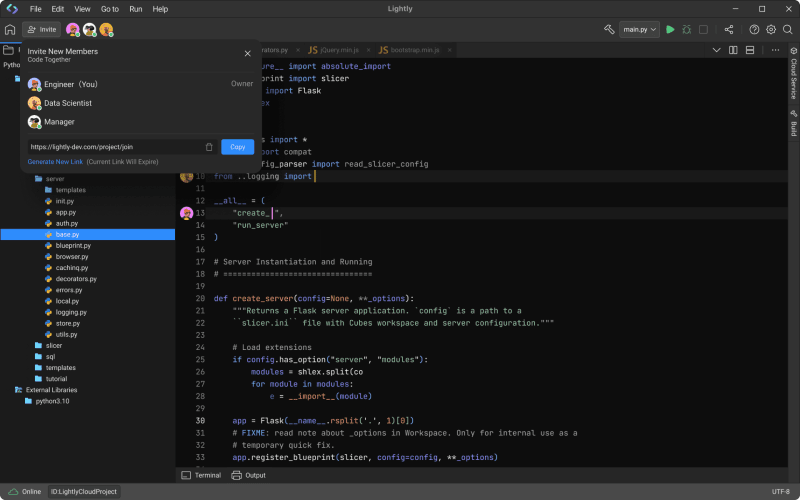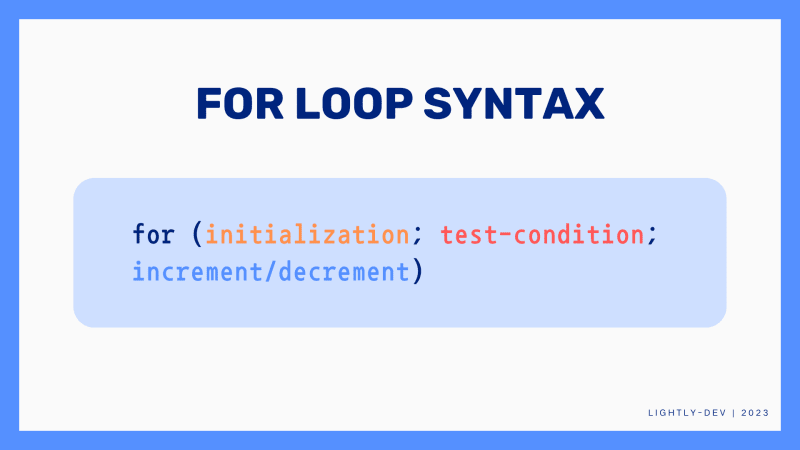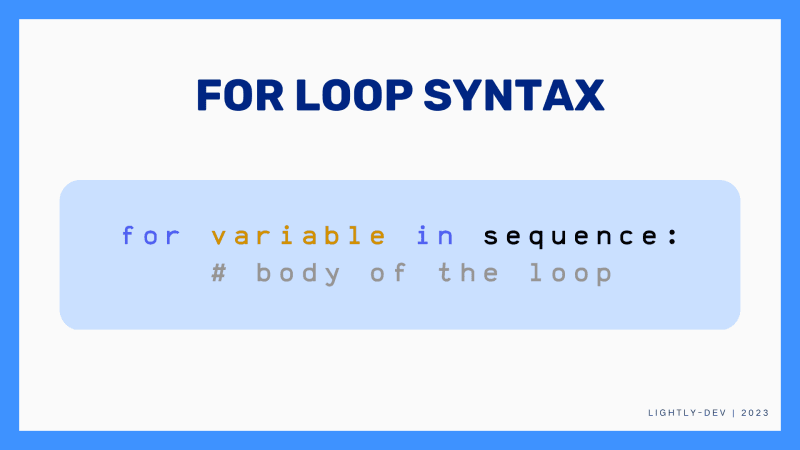For loop is a programming construct that allows a block of code to be executed repeatedly for a fixed number of times or for each element in a collection. The syntax of a typical for loop consists of three parts: initialization, condition, and increment/decrement:
The initialization step initializes the counter variable used in the loop. The condition step checks whether the counter variable has reached a certain value or condition. If the condition is true, the loop body is executed. Otherwise, the loop terminates. The increment/decrement step is used to update the counter variable at the end of each iteration.
For example, in Python, a for loop can be used to iterate over a sequence like a list or a string:
In this example, the loop iterates over each item in the sequence and executes the code block inside the loop body for each item.
A for loop without initialization occurs when the initial value of the loop counter is not defined inside the loop statement. Instead, it is initialized before the loop begins or outside the loop entirely.
Can for loop execute without initialization?
In most programming languages, a for loop requires an initialization statement that sets the initial value of the loop variable. However, there are some languages that allow for loops to execute without initialization.
One example is Python's for loop, which can iterate over any iterable object without requiring an explicit initialization statement. For example:
my_list = [1, 2, 3, 4, 5]
for item in my_list:
print(item)
This code will iterate over the items in my_list without an explicit initialization statement.
However, it's important to note that even in cases where an explicit initialization statement is not required, the loop variable still needs to have some initial value in order for the loop to work properly. In Python's case, the loop variable is set to the first item in the iterable object by default.
One situation where a for loop without initialization can be used is when you have already defined the starting value of the loop counter somewhere else in your code. In this case, including it in the for loop statement may make the code less readable and more cluttered.
Another situation is when you want to use a previous value of the loop counter as the starting value for the next iteration of the loop. This is especially useful when you are working with recursive algorithms or when you want to perform some iterative calculations using the results of the previous iteration.
Here's an example of a for loop without initialization that uses the previous value of the loop counter as the starting value for the next iteration:
int x = 0;
for (int i = 0; i < 10; i = x) {
x = i + 2;
// perform some iterative calculations using i and x
}
In this example, the loop counter i is initialized to 0 outside the loop, but is not reinitialized in the loop statement. Instead, it is assigned the value of x at the end of each iteration, which is equal to i + 2.
Examples of for loops without initialization.
JavaScript:
let i = 0;
for (; i < 10; i++) {
// loop body
}
Python:
i = 0
for _ in range(10):
# loop body
i += 1
Ruby:
i = 0
until i >= 10 do
# loop body
i += 1
end
Keep in mind that initializing the loop variable outside the loop can make your code less readable and harder to follow, especially if you are working with complex loops or nested loops. It's generally better to stick with the standard way of using for loops with initialization.
What are the advantages and disadvantages of writing a for loop without initialization?
In most programming languages, it is not possible to write a for loop without an initialization statement. This is because the loop control variable must be assigned an initial value before the loop can start executing. If you omit the initialization statement, the compiler will not be able to determine the initial value of the loop control variable, resulting in a compilation error.
If your programming language allows you to declare and initialize the loop control variable outside the loop, you can technically omit the initialization clause in the for statement. However, this approach does not offer any significant benefits and may affect code readability, especially for other developers who may need to spend extra time understanding the code.
In general, it is best to initialize loop control variables as usual when using a for loop to ensure code accuracy and readability.
Want try? Follow this guide: How to use a for loop without initialization in Python?
Lightly IDE as a Programming Learning Platform

Starting out with a new programming language can be daunting, but Lightly IDE simplifies the learning process for everyone. Designed specifically for beginners, Lightly IDE allows even complete novices to dive into coding with ease.
One of its standout features is its intuitive design, which makes it easy to use regardless of your level of experience. With just a few clicks, you can quickly begin programming in Lightly IDE.
Whether you're interested in learning programming or just starting out in the field, Lightly IDE is an excellent place to begin. It provides the optimal platform for mastering programming skills and is particularly well-suited for those who are new to the discipline.









Top comments (0)